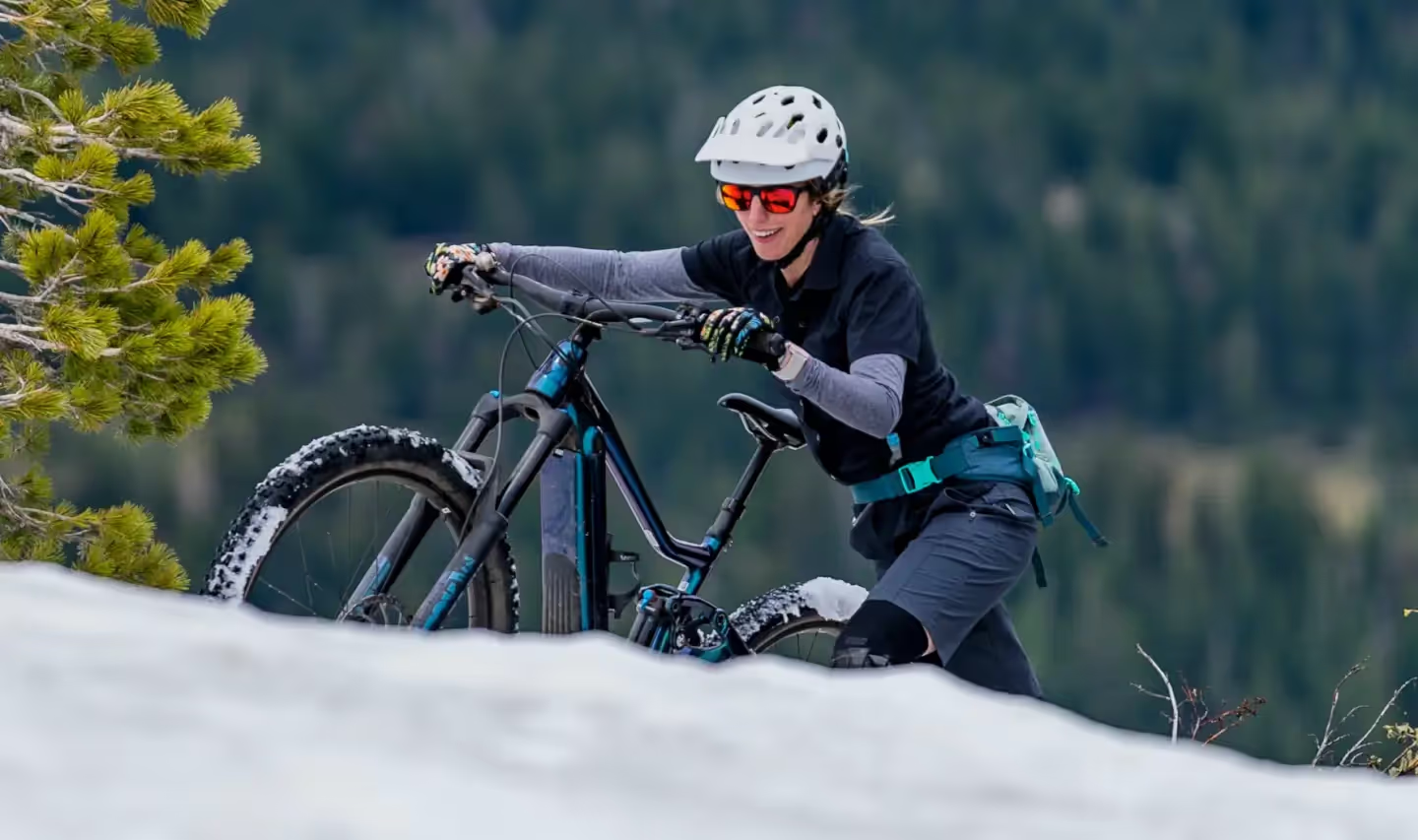How to ride your e-bike in winter
From an early age, we’re told electricity and water just don’t mix. But, back in those days, electric bikes didn’t exist. It’s inevitable that someday you’ll be out riding on a sunny day that turns rainy, or your summer purchase will need to keep carrying you through winter.

Here’s How to Safely Ride Your E-bike in Rain and Snow
From an early age, we’re told electricity and water just don’t mix. But, back in those days, electric bikes didn’t exist. It’s inevitable that someday you’ll be out riding on a sunny day that turns rainy, or your summer purchase will need to keep carrying you through winter.
Your first time riding in the snow can feel a lot like learning to ride from scratch.
It’s a whole new world - stopping distances are longer, freezing temperatures can affect your brakes and battery, and you’re likely to be in a different space (both physically and mentally) than you were in the carefree spring and summer months.
While most tips for riding an e-bike in the snow are similar to riding a traditional bicycle, there are some maintenance and riding tips unique to e-bikes. Read on to find out how you can keep riding safely all winter long!
Dress for Riding in the Cold
First and foremost, dress appropriately - and that doesn’t mean as warmly as possible!
Common wisdom says that when you start riding, you should be somewhat uncomfortably cold because your body heat will warm you up while you ride.
If it’s your first winter cycling in the winter, you might not have all the kit you need for a perfectly comfortable ride - and it can get expensive if you need to buy it all at once. Here’s what we think are the most essential items for winter cycling.

An Under Layer, Mid Layer, and Top Layer
Each of these layers serves a different purpose: The under layer keeps you dry, the mid layer warms you up, and the top layer protects you from rain or wind.
Having three layers also gives you room to remove items if you get too warm, so don’t substitute three layers for one super-warm jacket. Any other things that warm you up are a bonus, but without these three layers you’re going to have a really uncomfortable winter.
Lights
You might be convinced you’ll reach your destination before the sun sets, but any unexpected setbacks could leave you riding in the dark.
Only half the benefit of lights is for your own visibility, and the other (just as important) half is to ensure that motorists can see you. In the winter months, you should always have front and back lights with you, even if you’re sure you won’t need to use them. Better safe than sorry.
Protection for your Extremities
No matter how warm your body is, there are some parts of your body that won’t be able to retain heat: Your hands, head, and feet. Gloves, a beanie or balaclava, and thick socks should be able to get you through most winter days.
Ideally, you’ll want to get items that are specifically made for cycling but in a pinch, you can use the things you already have.
Mudguards
Even the best winter kit won’t do much to protect you if you’re constantly splashing mud, snow, and water up into your face and back while you ride. Many cyclists don’t like the look or bulk of mudguards, but we’d venture to guess that riding wet is an even less appealing option.
Your First Time E-biking in the Snow
When you hop on your e-bike for the first time in the snow, turn off your pedal assist so you can get a feel for your e-bike’s handling. You can slowly increase your pedal assist as you become more and more comfortable with the extra power.
Even after practicing, you may find that you don’t feel confident going as fast as you would in the warmer months, so don’t put pressure on yourself to match your summer speeds. Safety first!

While riding, be aware that road conditions can change from wet to icy, and it isn’t always easy to spot where it changes. If you find yourself suddenly on ice, stay steady and slow down. The last thing you want to do is panic and lose control.
Generally, cyclists will use their front brake for slowing down and their back brake for stopping - but those rules go out the window when you find yourself on ice. You want all the front traction you can get.
If you do need to use your front brake too, use it gently in conjunction with your back brake so your front wheel doesn’t stop rolling.
If the worst happens and you crash or damage your ebike in the snow, at least you’ll know Sundays insurance has your back. According to data collected by Sundays arranger Gator Bikesure, here are the most common accidental injury claims received during winter 2020 - 2021:
- 9% due to crash from darkness (poor visibility).
- 9% due to another cyclist stopping suddenly.
- 32% are caused by cars. This primarily arises from either being hit by a car, due to a car stopping suddenly, or a motorist opening their door without checking for cyclists.
- 50% due to bad roads, with 90% of these claims attributed to wet roads, and the remainder due to gravel/ deteriorated roads.
Give Your Battery Extra AttentionBatteries like to live in the Goldilocks zone - where it’s not too hot, not too cold, just perfect. Unfortunately, winter has its own plans. Here’s how you can keep your battery safe throughout winter:
- If you store your e-bike in a shed or garage, remember to bring your battery inside with you if the temperature is going to drop below 10oC.
- If you’re not planning on riding in winter, charge your battery to between 50% and 70%, bring it inside with you, and charge it to full before your first ride.
- Charging your battery from cold can damage it. After a ride, bring it indoors and let it get to room temperature before charging.
- If your e-bike’s battery is non-removable then you should store the entire ebike indoors.
What to do if you Have an Accident on Your E-bike
- Find a safe spot. If you’ve crashed in the road, do whatever it takes to get yourself out of the road and out of harm’s way. If you can’t move, call emergency services immediately. If you’re unable to call, enlist a bystander to call. Studies have shown that the bystander effect often stops people from taking action so point out an individual, make eye contact, and ask them directly for help.
- Do a full body check. Check if there’s any damage to your helmet, whether you can stand up, and whether you can remember the basics (your name, your address, your phone number). Adrenaline can hide your pain, so if you’re uncertain, rather call a friend, taxi, or ambulance to take you to the hospital.
- Don’t worry about your e-bike. If your e-bike is covered with Sundays insurance, it will be covered for accidental damage as a standard part of your cover, and we’ll repair or replace your ebike or parts as quickly as possible.
- Don’t rush to get back on your e-bike. Whether you’re healing an injury or overcoming a mental block or lost confidence after a crash, be patient with yourself. When you’re ready to ride again, start out slowly with routes you know well and are comfortable with.
Frequently Asked Questions
Can I ride my e-bike in the rain and snow?
Yes, you can ride your e-bike in wet and snowy conditions, but you should take precautions to stay safe, such as adjusting your riding style and ensuring proper maintenance.
How do I brake safely on icy roads?
Use your back brake for stopping and your front brake gently in conjunction with it. Avoid sudden braking to prevent losing control.
How should I take care of my e-bike battery in winter?
- Bring your battery indoors if temperatures drop below 10°C.
- If storing the bike for winter, keep the battery at 50%-70% charge and recharge fully before using it again.
- Never charge the battery when it’s cold - let it reach room temperature first.
- If your e-bike has a non-removable battery, store the entire bike indoors.




